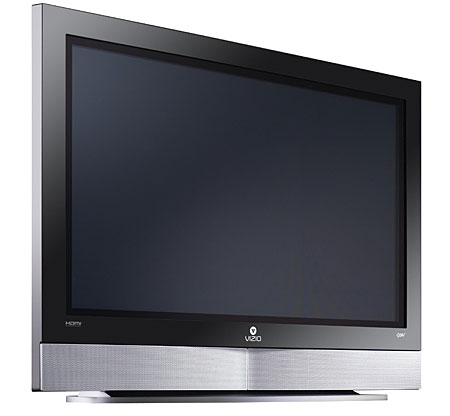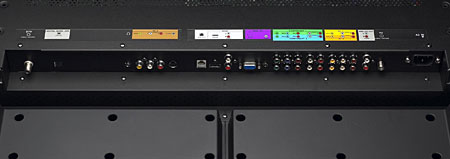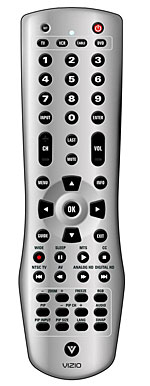VIZIO P42HDTV Plasma

Plasma prices, however, are now falling everywhere. For example, Panasonic, another manufacturer of excellent plasma sets, is now selling a similarly equipped model for $2,499 – list price. Street prices I have seen are as low as $1,799. A common "street price" for the VIZIO is $1,399, so my point is that you can now buy a variety of 42-inch plasmas at relatively affordable prices. The Panasonic, though it costs more, does have one feature the VIZIO does not – a CableCARD slot for digital cable and HD.
Like nearly all of its 42-inch, 16x9 brethren (including Panasonic's) the VIZIO calls itself an HDTV even though the native resolution is 1024 x 768, which falls below the minimum horizontal resolution threshold a set must offer to call itself an HDTV. But the industry seems to have abandoned restraint in marketing claims when it comes to this particular point, choosing instead to rely on the vertical resolution to proclaim a set as having an HD pixel count.
Stylistically, the VIZIO is similar to its 50-inch cousin, a basic HD monitor (with neither an HD nor an NTSC standard definition tuner) that sells for $2,499. A relatively large, black frame surrounds the screen. Speakers are set into a silver panel at the base. Basic controls are on the right side of the frame. The set comes out of the box already set into its tabletop base. If you want to hang it on the wall, VIZIO offers several hardware options at additional prices. For $399, the company will set it up and mount it on a wall, too.
The set comes with almost all of the features consumers expect these days, including all the normal analog inputs and an HDMI input as well, which may prove to be essential in the months ahead if you buy a high-definition disc player. Also built in are both analog and digital television tuners.
The remote, silver with well-labeled black buttons, is good for a set at this price. It is not backlit but is well organized. The remote offers both an input menu button to bring up a scrollable, on-screen input list and direct input selection buttons. The set also offers four aspect ratios for watching 4:3 shows on this 16:9 screen, including a stretch mode that keeps the center largely intact while stretching the edges.
I found the TV quite easy to set up. Large, bold on-screen menus draw you through the options, including searching for both analog and digital channels. (More on that later.)
First impressions
Turn the set on, and it provides a better picture out of the box than many TVs I have seen. The brightness and contrast are not pre-set to turn the TV into a widescreen searchlight. For this review, we decided that TJN in Los Angeles would get a second review sample, for calibration and testing, while I tweaked this set using only the user-accessible menu adjustments.
I have argued that full-bore ISF calibration makes sense for expensive sets but not for many that are at this price range – particularly if they come with settings close to the optimal to begin with. This set proved my point. TJN found that the color temperature settings were within a reasonable striking distance of optimal (see the "Testing and Calibration" sidebar.) Close enough that ISF calibration would probably not make sense, no matter the price of this set.

I ran the set through the full range of tests and charts in both the Video Essentials and Silicon Optics HQV Benchmark test discs. By most tests the set fared quite well.
The VIZIO showed unusually good predictability and stability for a plasma, many of which have quirky problems, like displaying different shades of grey at different places on the screen, dot patterns, or white dots on a black screen. The dots are not round, and the phosphors misfire so that the dots have a red or green tinge. On the VIZIO, the dots were rendered perfectly.
Color rendition was good, but the set exhibited significant red push – a failing of every TV I've reviewed. To compensate for that, the color control had to be dialed down, which negatively affected the balance of all the other colors.
The scaler is one of the most critical features of any digital set. The circuitry used to convert incoming signals to the set's native 1024x768 resolution can introduce noxious noise and interference. VIZIO's scaler is better than average. The Silicon Optix disc offers several tests for scalers and, while the VIZIO did not perform at the very top of the scale, it was close in most cases -- reliably good. And in fact I could see a few subtle jagged lines and related video noise, but that was not a serious problem that regularly interfered or detracted from the pleasure of watching.
The test discs and regular programs did display a fair amount of video noise in dark scenes. In the old days people often called this "snow," though in the NTSC era "snow" was the result of reception, not display, problems. Digital noise is similar looking but much more subtle. At a reasonable viewing distance, it was largely invisible.
Black levels are the biggest problem of most plasmas displays. Even the best of them still cannot equal a CRT. The greater the problem with black levels, the less details you will see in dark scenes, and less over-all contrast the TV will offer. The very best plasma I have seen for black levels was the Panasonic TH-42PHD8UK, reviewed in February, though even it could not provide the degree of contrast I can get on a good CRT. But the VIZIO was up there with most other top-of-the-line plasmas.
 The set offered superb resolution, and when watching program material on DVDs it provides a credible and enjoyable picture with no real flaws. But it did not provide that ineffable, sit-up-in-your chair pop that some other plasmas provide. I enjoyed watching the VIZIO, but it did not leave me with a sense of wonder. This is a wholly subjective evaluation, and I don't think my view was colored by the price. That Panasonic I reviewed a few months back cost a few hundred dollars more and it did force me to sit up. Maybe it was the difference in black level and the improved contrast that comes with it.
The set offered superb resolution, and when watching program material on DVDs it provides a credible and enjoyable picture with no real flaws. But it did not provide that ineffable, sit-up-in-your chair pop that some other plasmas provide. I enjoyed watching the VIZIO, but it did not leave me with a sense of wonder. This is a wholly subjective evaluation, and I don't think my view was colored by the price. That Panasonic I reviewed a few months back cost a few hundred dollars more and it did force me to sit up. Maybe it was the difference in black level and the improved contrast that comes with it.
After watching DVDs I set out to watch some HDTV, using the set's built-in DTV tuner. I disconnected the antenna lead from my Sony outboard digital tuner and connected it to the DTV RF input on the back of the VIZIO. The set quickly ran through the station search and found six channels, fewer than the total number I usually get. But when I tried to watch even the channels that the tuner found, it was unable to hold a solid lock on any of them. I have never before seen an HD tuner that was unable to bring in even one channel, even the first one on the market that I reviewed in October 1998.
Right away, I switched the antenna lead back to my Sony digital receiver, connected the Sony to the VIZIO using a component input, and low and behold I was able to view all of the digital channels with no problems. Something was wrong. I contacted VIZIO and explained the problem. I was told there had been no complaints about the digital tuner. My review sample must be defective, they concluded, so they sent me a second sample that was only marginally better.
I have reviewed almost every outboard digital tuner on the market over the last eight years – more than a dozen of them. Every one of them has been subjected to exactly the same review scenario – connection to my rooftop antenna in the test studio in my basement. All of them are generally able to display the signals from all the digital channels without much, if any trouble. I don't see how the digital tuner problem in the two VIZIO sets can be explained away.
In any case, using outboard tuners the VIZIO was able to display a credible, pleasant, enjoyable near-high-definition image. Like the Panasonic and Hitachi sets offering the same resolution I reviewed in December and February, "higher definition" on the VIZIO did not quite feel like HDTV but still was much better than NTSC.
This set offers quite a lot for the price and performed unusually well right out of the box. Its most glaring problem, the digital tuner, may be irrelevant if you intend to get your HDTV programming from a satellite or digital cable service. If price is a critical issue, this set deserves a serious look.
Highs and Lows
Highs
Excellent picture for the price
Looked good right out of the box
Strong feature set
Lows
Unacceptable digital tuner
No CableCARD capability













































